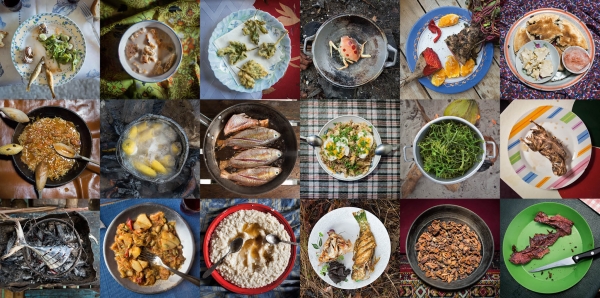
Paleo is certainly a buzzword in the diet and health communities, but do people really know what it means when they say they “want to eat like their ancestors?” National Geographic’s Evolution of Diet investigates what an original Paleolithic diet might have been, and how the modern diet developed.
To start, they first looked at the few groups of true hunter-gatherers remaining — those whose diets haven’t changed much in thousands of years.
“Hunter-gatherers are not living fossils,” Alyssa Crittenden, a nutritional anthropologist at the University of Nevada, Las Vegas, told National Geographic. “That being said, we have a small handful of foraging populations that remain on the planet. We are running out of time. If we want to glean any information on what a nomadic, foraging lifestyle looks like, we need to capture their diet now.”
Hunter-gatherers traditionally don’t develop high blood pressure, atherosclerosis, or cardiovascular disease. In fact, many believe it is the modern human diet that causes these health problems. This thought is what drives the current craze over Paleolithic or Stone Age diets.
It’s true that ancient hunter-gatherers were healthier than those who rely on agriculture to supply their food. Biological anthropologist Clark Spencer Larsen told National Geographic that early farmers became dependent on their crops, and developed health problems that were uncommon in hunter-gatherers, like periodontal disease. Domesticating animals as livestock also exposed humans to new infectious diseases.
Though, National Geographic points out, an actual Paleolithic diet wasn’t solely comprised of meat and marrow. In fact, most hunter-gatherers went through times when meat was scarce and they had to rely on something else to fuel their growing brains.
“There’s been a consistent story about hunting defining us and that meat made us human,” Amanda Henry, paleobiologist at the Max Planck Institute for Evolutionary Anthropology told National Geographic.
“Frankly, I think that misses half of the story. They want meat, sure. But what they actually live on is plant foods.” She has also found that starch granules on fossil teeth and tools that suggest humans have been eating grains for at least 100,000 years. That’s plenty long enough to have developed a way to tolerate them, punching a hole in claims that humans are meant to follow a meat-centric diet.
So if a meat-centric, Paleo diet isn’t the answer, what is?
Some, like Harvard primatologist Richard Wrangham, believe the cause of the decline in human health is due to cooking. The body spends less energy breaking down cooked food, which means more fuel for our brains and fewer calories burned. Since most of us are less active than our Paleolithic ancestors, the extra energy and calories turns into weight gain.
“Rough breads have given way to Twinkies, apples to apple juice,” Wrangham told National Geographic. “We need to become more aware of the calorie-raising consequences of a highly processed diet.”
Through their research, National Geographic found that there may not be just one true Paleo diet. There’s great variance in what food is available in different regions of the world, and the people who live in those regions evolved accordingly. Certainly, there is no one diet that encompasses the eating habits of ancient humans.
Also Read:
5 Reasons Why Most of Us Should NOT Go Gluten-Free
Most Americans Clean Their Plates. Most Americans are Obese. There is a Connection
Did Cavemen Follow the Paleo Diet? Probably Not
Photos by National Geographic
